

Curly Toes
Information for Families – Curly Toes
What are curly toes?
This common condition is usually present at birth but can become more noticeable when your child starts walking. It tends to occur in the third, fourth and fifth toes on one or both feet. The toes curl under because the tendons that flex (bend) them are too tight and pull the toe under the next toe, curling it towards the underside of the foot.
What are the symptoms of curly toes?
The main concern is the visible curling of the toe. In the majority of people curly toes don’t cause too many problems. Sometimes, symptoms such as hard skin, rubbing, or pain can occur as well as problems getting shoes to fit.
What causes curly toes?
We do not know exactly what causes the tendon to be tight, but it has been noted that the condition can affect several generations, which implies that it is passed on from parent to child (inherited).
What is the Natural History of this condition?
If the toes remain supple and flexible they continue to be curly but don’t cause a problem. Sometimes a curly toe can becomes fixed, as the joint capsule also becomes tighter, but there is no evidence to show this causes more problems in later life.
How can it be treated?
Stretching – In the first instance we always recommend stretching out curly toes to keep them supple. This can be done daily as part of a bedtime or bathtime routine. Some doctors and physiotherapists advocate taping to the adjacent toes to hold the curly toe out straight but I feel this has limited value.
The most important point is to reassure you that curly toes usually don’t cause a problem.
Surgery – However in a small number of cases if the toes are causing significant trouble such as ongoing painful blisters or rubbing, I can perform a small operation on the underside of the toe to release the tight tendon. This is done under a general anaesthetic as a daycase procedure. At the time of consent, I would discuss the procedure in detail with you, the benefits and the risks of the surgery, as well as the postoperative care. Approximately 1 in 10 cases (10%) require this simple straightforward procedure.



